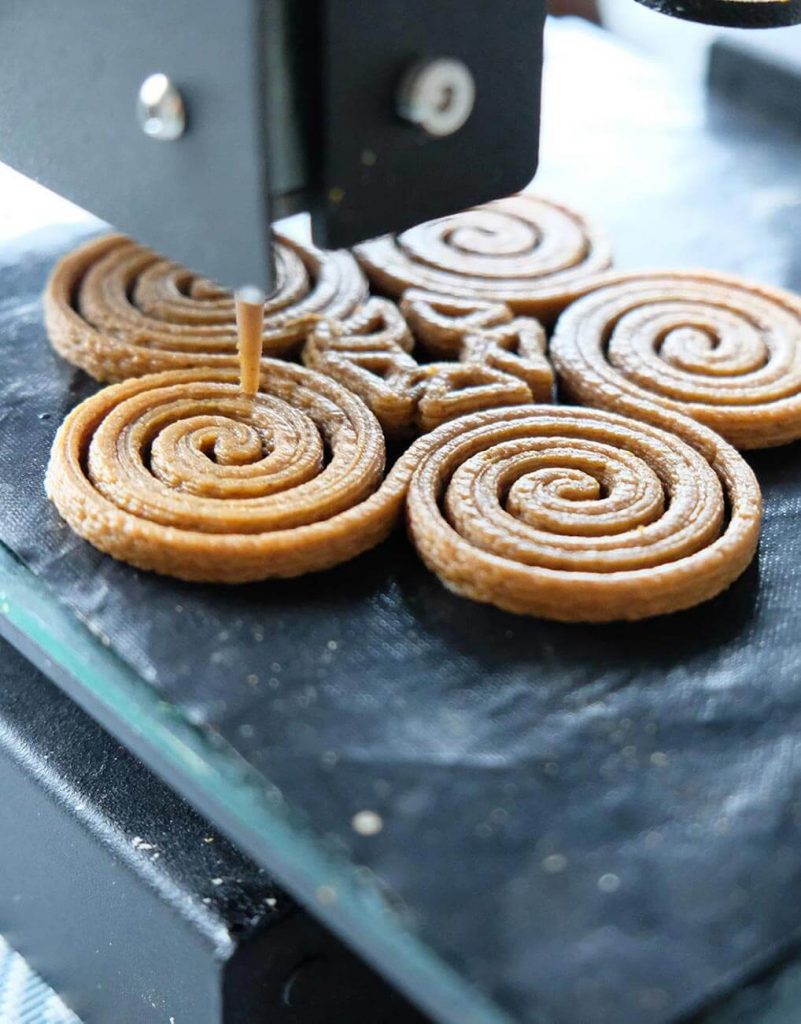Yes, this is a question our children could ask us in the future… Over the last decade, 3D printing is advancing at a rapid pace and is now exploring the food industry. 3D printing food is not solving any major problems, nor is it increasing cooking efficiency yet, however, who knows what the future holds for us. 3D printing food can be argued to be a disruptive innovation according to Christensen et al. (2015) as it brings a new dimension to food by creating the ability for people to create textures, shapes and designs that would have been impossible by hand. Therefore, it taps into a non-existent and niche market and has not yet been explored by incumbents.
How does it work?
In this video (https://www.youtube.com/watch?v=5IpqV15frb4), there is a demonstration of the process of food printing and cooking food by using lasers at the Columbia University. To start off, the entire process is about software; from the actual designing of food to the programs that run the lasers to cook the food to the exact degree you would desire. Inside the 3D printer, there are cartridges that hold liquids and/or pulverized ingredients. The cartridges can be filled with almost any food you desire as long as it is able to be properly pulverized, even salmon as mentioned in the video. The food itself can be designed using software in which you are able to design whatever you want with the food cartridges at your disposal.

So what?
With the endless possibilities of new designs and accurate laser cooking precision, chefs will be able to experiment with food in ways that people have not experienced before. This creates a great opportunity for restaurants and bakeries to offer their clients a unique experience. Additionally, 3D printing has the potential to combat the food waste problem. Residual food flows can be pulverized and mixed to create delicious purees that can be used to fill up 3D printing cartridges (Upprinting Food, n.d.). The technology has not matured enough yet to be scalable as it still requires a lot of time to design and develop (Carolo, 2021). Nevertheless, as efficiency and massive adoption are increasing with the advancement of this new technology, do not be surprised to see 3D printed food on your plate one day.
References
Carolo, L. (2021). 3D Printed Food (2021): All You Need to Know. All3DP. https://all3dp.com/2/3d-printed-food-3d-printing-food/
Christensen, C. M., Raynor, M. E., & McDonald, R. (2015). What is disruptive innovation. Harvard Business Review, 93(12), 44–53. https://doi.org/10.1353/abr.2012.0147
Upprinting Food. (n.d.). Sustainable Food Printing. https://www.upprintingfood.com/
https://www.youtube.com/watch?v=5IpqV15frb4
Pictures
Upprinting Food. (n.d.). Sustainable Food Printing. https://www.upprintingfood.com/
https://www.ge.com/additive/additive-manufacturing/industries/food-beverage
References


Catchy title Rutger! I agree with you that 3D printed food has immense advantages for chefs who want to experiment with the ‘artistic’ side of cooking, but I also wouldn’t underestimate the potential of this technology to reduce carbon emissions. 3D printed meat for instance has great potential in reducing greenhouse gas emission. Firstly, only the required amount of ingredients will be used, thus reducing food waste. Next, less land, less energy, feed and water are also required to raise the animals. Overall, the prospect of resources involved in keeping this operation active is far less than traditional farming methods.
What’s more interesting is how fast 3D food printing companies are gaining traction. Just recently, CellX raised $4.3 million in funding for printing more pork! There’s no doubt that these innovative methods of producing food would be costly initially, but I think investors are becoming more keen in these technologies, so that should being the prices down in the near future!
This is a major step in the right direction in reducing our carbon footprint!
Hi Yash thank you for the insightful comment. You are right on the carbon emission reduction part, meat production is a huge emitter of greenhouse gasses and one of the solutions could indeed be 3D food printing. We are able to create and combine food that we thought would not be possible in the past. A nice example of CellX, very cool! I hope this trend continues and innovative 3D printing technologies will play an important role in the sustainability of our future generations.
Cool post Rutger! I like that you used a video to demonstrate the process of food printing. It really helped to get a clear view of this new innovation. I’m doubting if 3D printing food actually is or will be a disruptive innovation. Yet, not so many people can make use of it and it is not widely adopted by restaurants et cetera. I do not believe that he customer experience will increase by the usage of 3D printing. Why do the customers get more value when their food is coming from a 3D printing machine? I am not sure if that will be the case but I am looking forward to where this is going in the future. Furthermore, I really like that this new technology has the potential to combat the food waste problem. More business models should focus on this. I really liked reading your article, you did a great job! It is very informative and educational!
Thanks for your comment Christel! There are indeed many unexplored opportunities in the 3D printing space that may sound absurd today but could be a reality in the future. 3D printing allows creating food in ways that could not be done by hand before, this is why it could target a higher customer segment. I am curious what the future holds for 3D printing, will it combat the food waste problem or be used to add more value to a restaurant experience? Or both and more? Who knows…